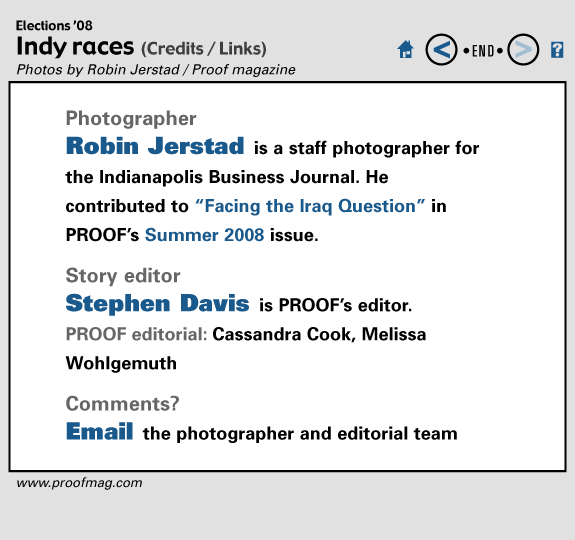

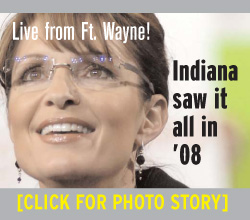

Links & notes
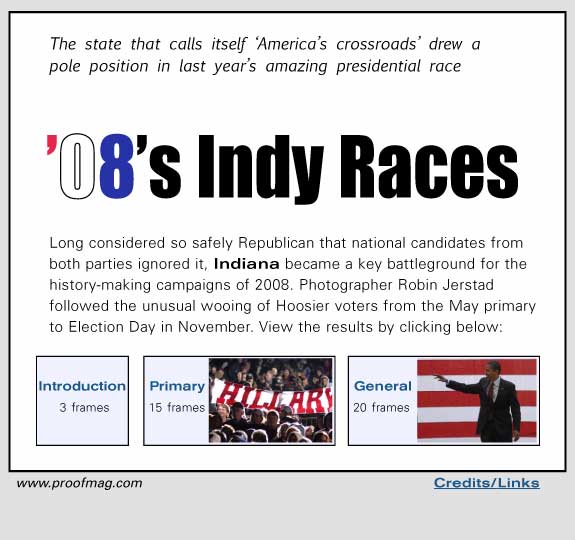
Robin Jerstad estimates he shot 3,000 images for this story. Read the bonus commentary below for insight into the three dozen that were selected to tell the story of Indiana’s history-making elections . . .
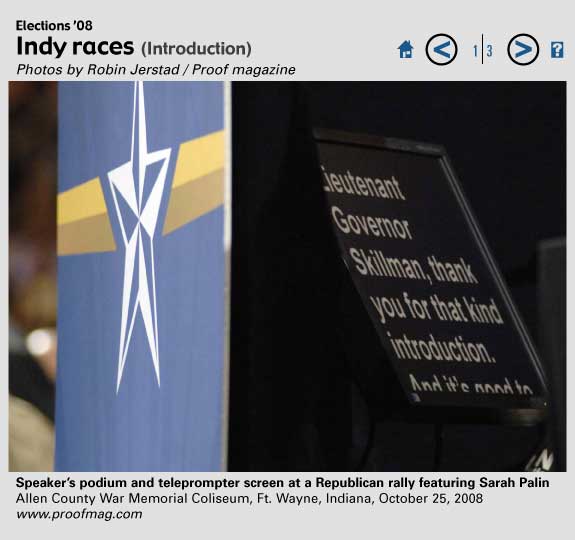
Introduction
The 2008 campaign turned a little-known governor from Alaska into a household name.
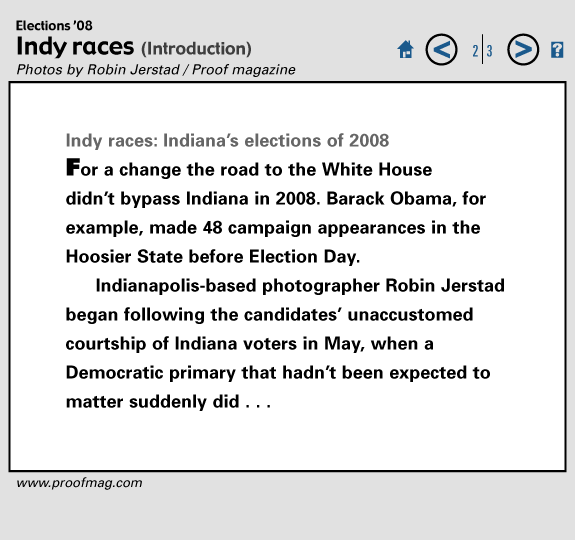
TIP: Add music to turn this photo story into a photo opera (photo-op for short). Some listening suggestions for this story:
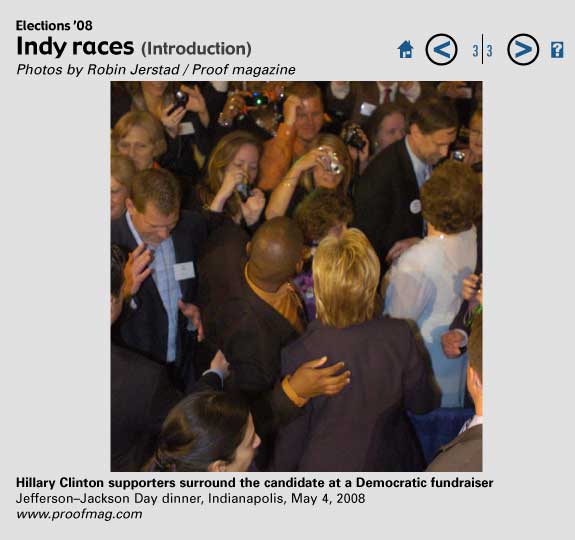
Hillary Clinton was the Democrats’ front-runner when she announced her candidacy in January 2007, one year before the first primary votes would be cast.
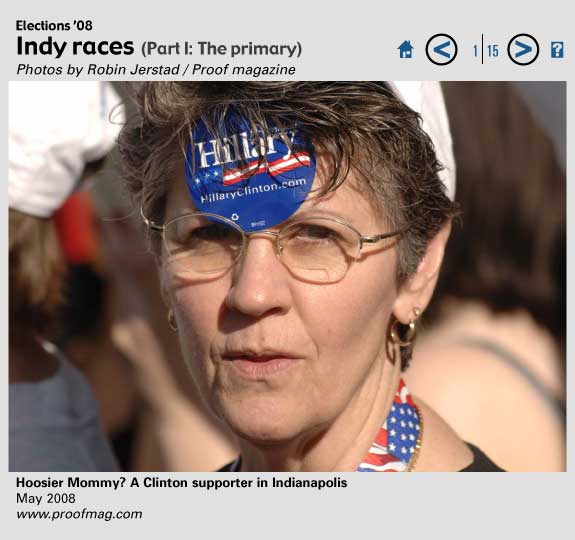
The primary
Indiana is significantly whiter (83% in 2007) than the U.S. as a whole (66%). The state’s median household income, $47,448 in 2007, is just below the national average of $50,740.
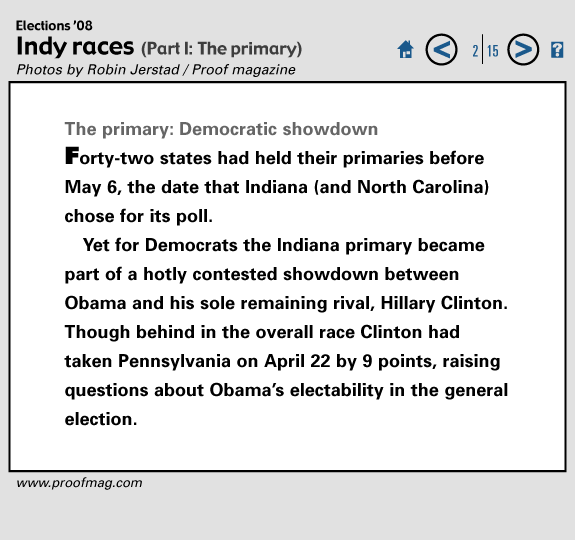
By contrast Indiana’s Republican primary (also held May 6) was mostly a formality, since John McCain had clinched his party’s nomination in early March.
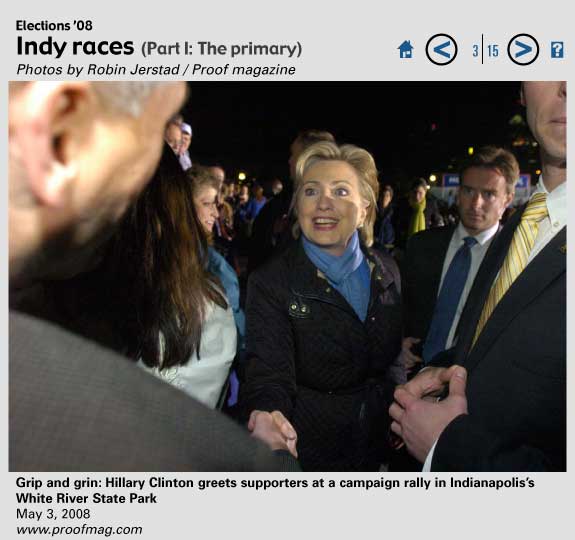
White River State Park is a reclaimed industrial zone located a half-dozen blocks from downtown’s Monument Circle, the putative center of Indianapolis.
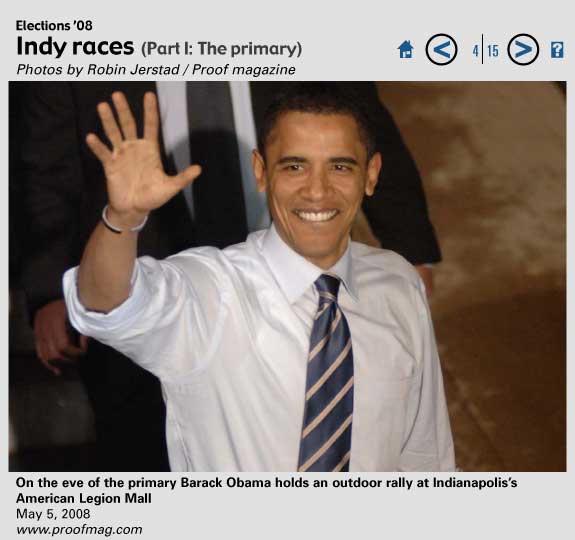
A landmark greensward in Indianapolis’s central business district, American Legion Mall occupies the north end of War Memorial Plaza, a five-square-block quad just north of Monument Circle.
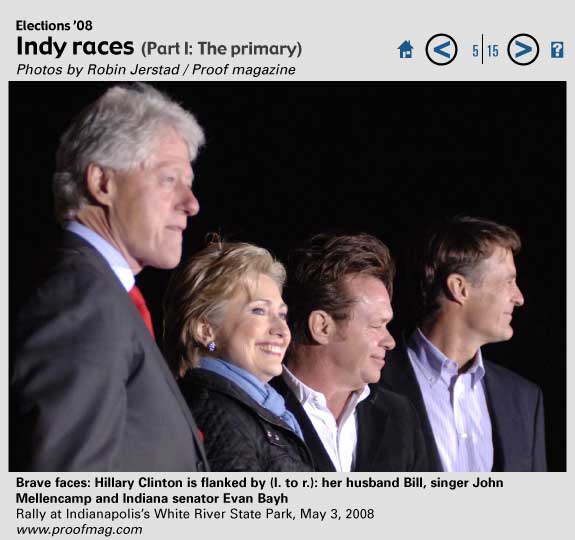
Bill Clinton won Indiana’s Democratic primary both times he ran (1992 and 1996). Mellencamp may be Indiana’s most famous home-grown rocker. Currently in his second term as U.S. senator, Bayh is one of Indiana’s most popular Democratic politicians ever.
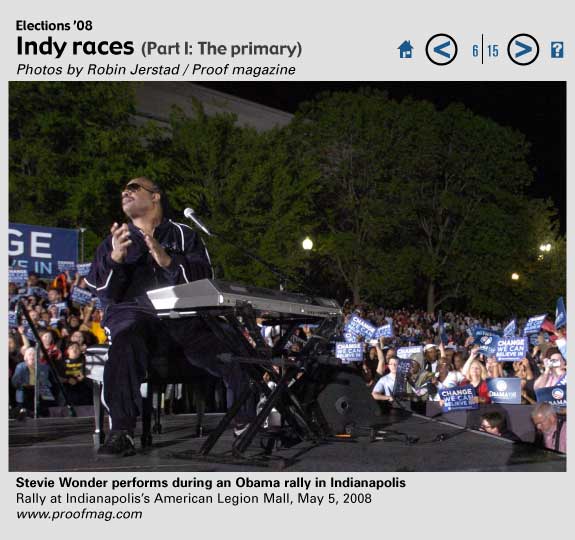
Wonder performed at many Obama campaign events, culminating with the outdoor rally during the Democratic convention at which Obama formally accepted his party’s nomination.
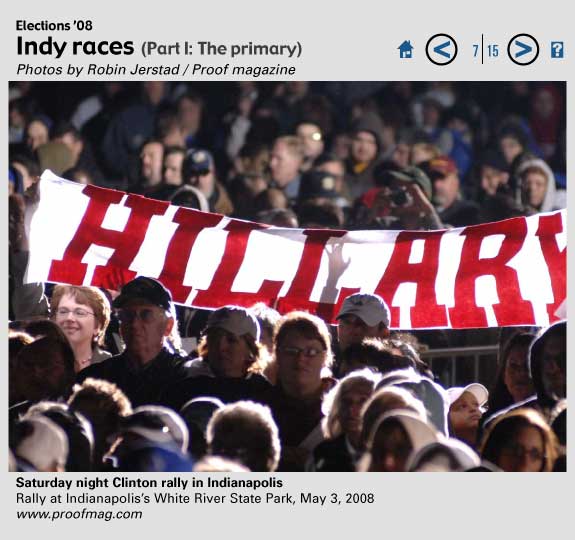
Homemade signs were forbidden past the security checkpoints at all of the rallies depicted in this story, notes photographer Robin Jerstad. “The signs and banners that you see in the images were given to people by [each] campaign and were strategically placed for maximum exposure to the cameras.”
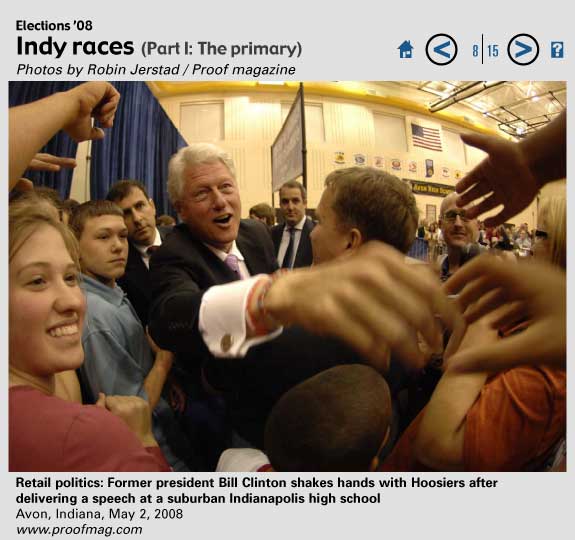
Bill Clinton’s enthusiasm for the hustings proved a mixed blessing for his wife’s campaign. In January the former president drew much-reported criticism for belittling an expected Obama win in South Carolina.
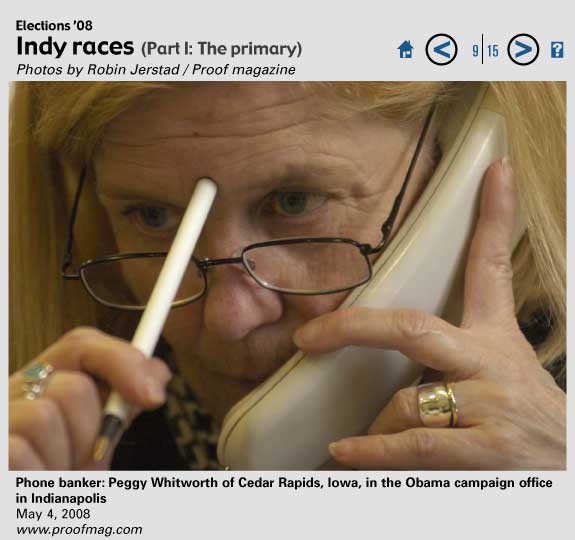
Obama’s strength in grass-roots organizing was key to winning Iowa’s first-in-the-nation primary. For many Americans his victory speech from Iowa the evening of January 3, 2008, was their introduction to the new contender.
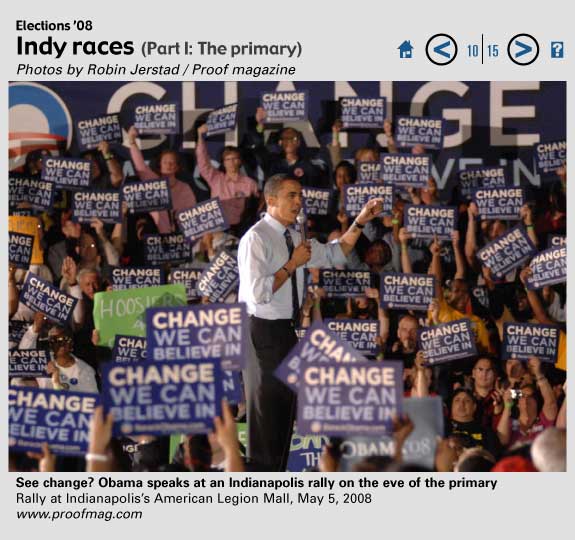
“Change” was Obama’s dominant theme, but one month after Iowa the Democrats were down to two candidates and over the next three months, the policy differences between Clinton and Obama largely receded. In March campaign coverage focused on Obama’s association with a fiery Chicago preacher.
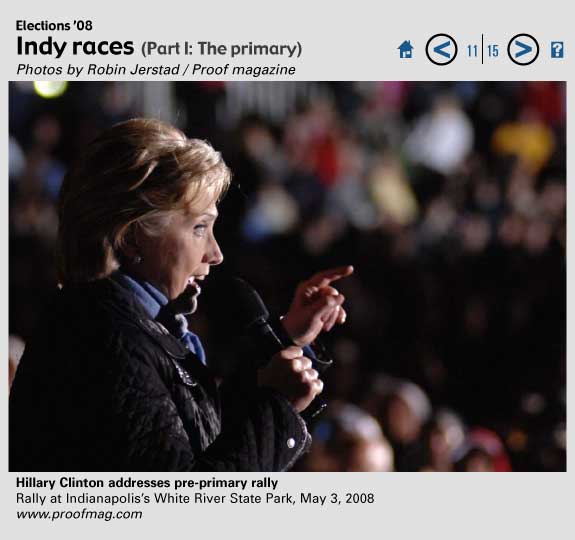
The Jeremiah Wright controversy was displaced, in turn, by one over Obama’s description of small-town Pennsylvanians as “bitter” over job losses and “clinging” to their guns and religious beliefs as a result. Campaigning in Indiana in April Clinton called Obama’s remarks elitist and divisive.
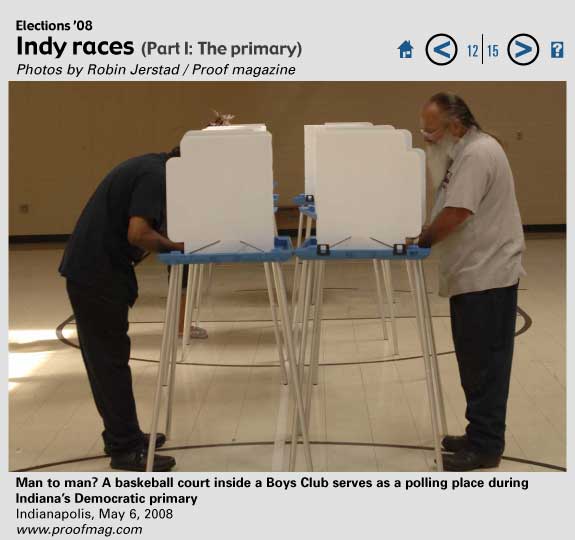
In the wake of Clinton’s Pennsylvania win, such contretemps raised the crucial question of electability: How would the Democrats’ leading candidate fare when he faced November’s nationwide referendum?
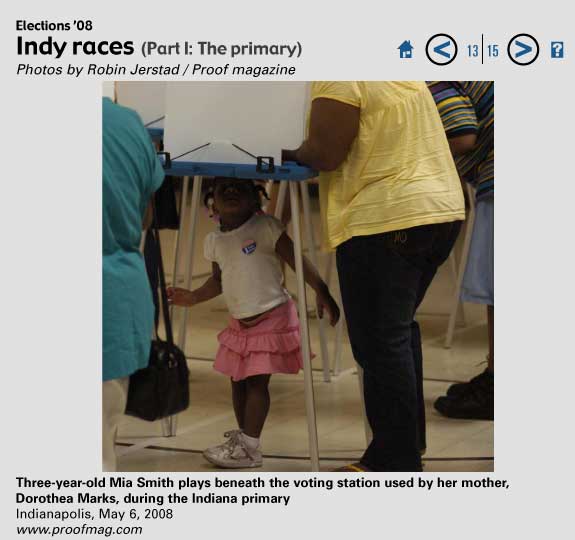
Nearly 1.7 million votes were cast in Indiana’s primary—more than double the turnout in 2004. African Americans cast one in seven Democratic votes in Indiana, compared with about one in three in North Carolina, which also reported record turnout.
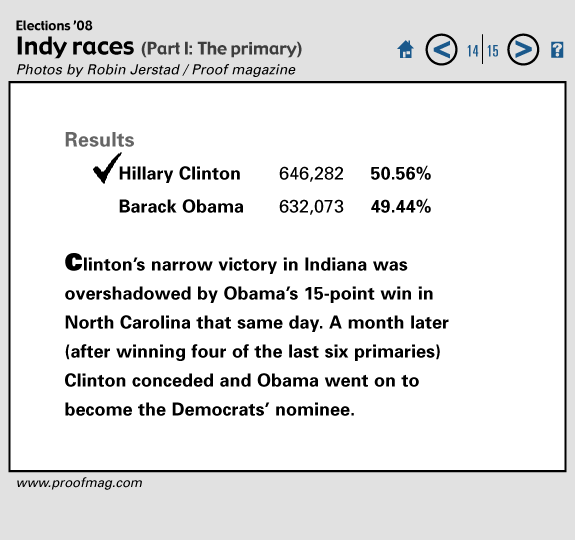
Similar percentages of Indiana and North Carolina voters—just under half—said the Jeremiah Wright controversy was important to their vote, according to the Associated Press’s exit polling. But the economy was the number one issue for two-thirds of Indiana voters and nearly that many in North Carolina—the highest such results in the AP’s primary season polling to that date.
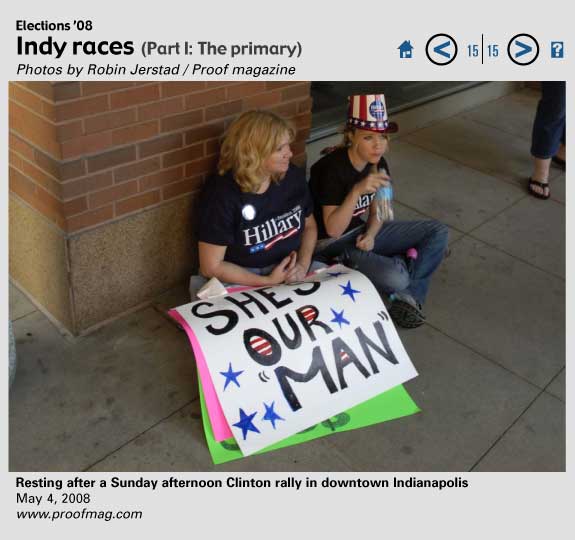
Clinton’s failure to win the Democratic nomination was one of the biggest surprises of 2008. She nevertheless led many Americans to take seriously the idea of a female U.S. leader—a breakthrough that future chroniclers will likely compare with the history-making result that was to come in November.
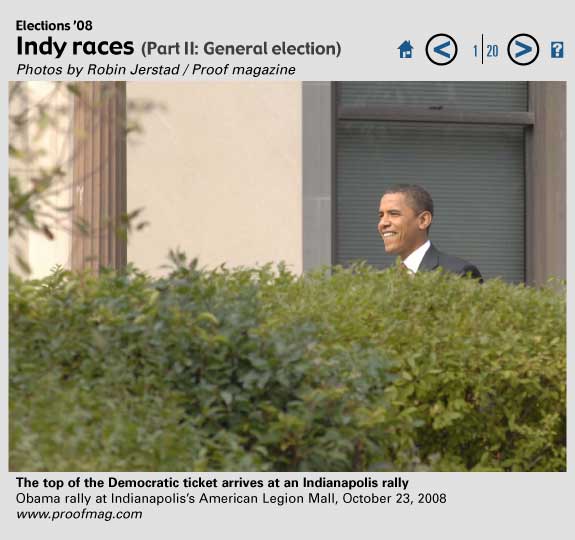
General election
Barack Obama announced his v.p. choice, Joe Biden, on August 23, two days before the Democratic convention began in Denver. The two-month v.p. selection process was noted for its lack of leaks.
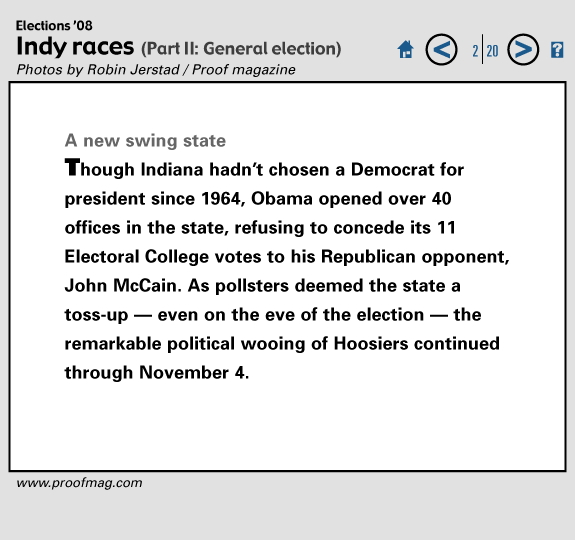
Another Republican thought not to be a shoo-in with Indiana voters in 2008 was the incumbent governor, Mitch Daniels, whose zeal for privatization has been controversial. In the end, though, Daniels won reelection by over 17 points. Neither of Indiana’s U.S. senators had to face the voters this year.
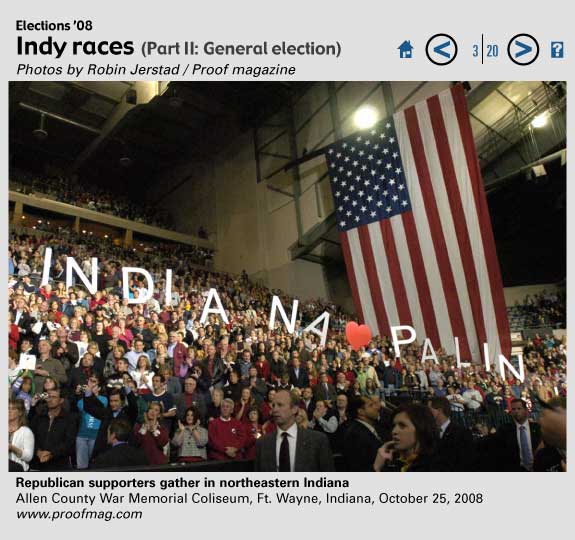
News that John McCain had selected a running mate leaked during the Democrats’ convention. The day after the convention was concluded, on his 72nd birthday, McCain introduced Sarah Palin at a campaign rally in Ohio.
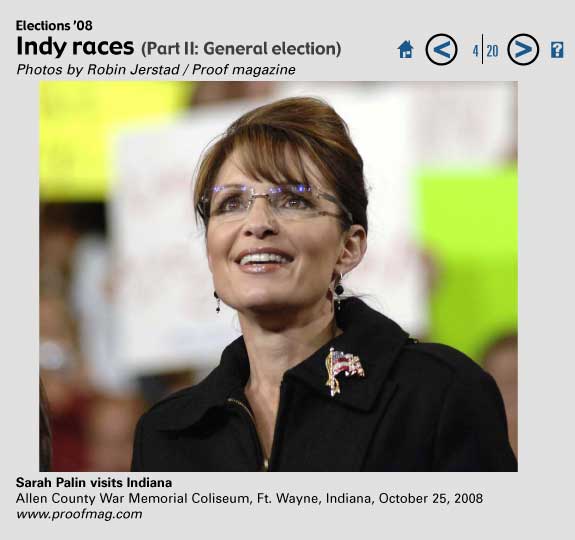
Palin, 44, was the fall campaign’s sensation. Her October 18th guest appearance on Saturday Night Live earned the show its biggest audience in 14 years.
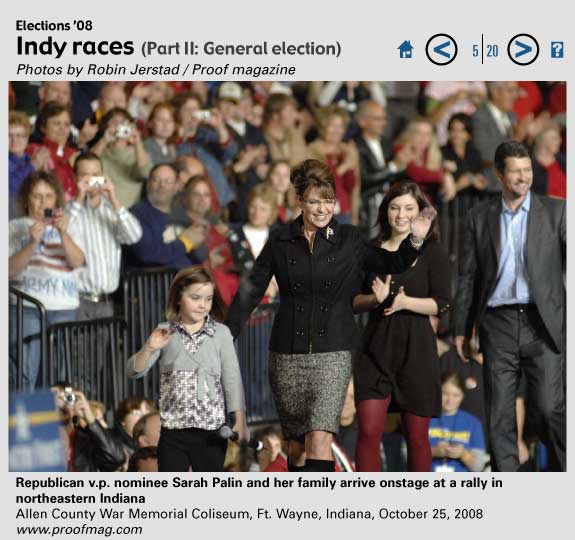
“The crowd seemed genuinely thrilled to have her there,” photographer Robin Jerstad recalls, despite having to wait over an hour: “There were only eight metal detectors [for a crowd of 10,000] . . . overall just very poor planning.”
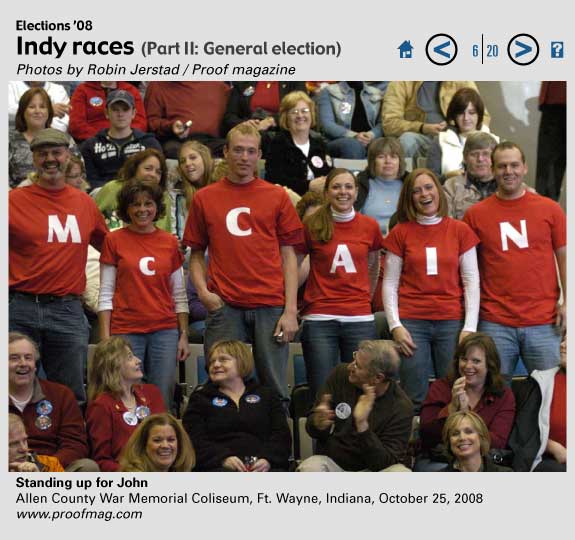
Palin helped McCain with voters he couldn’t take for granted: conservatives and Republicans. But moderates and independents were less enamored of McCain’s v.p. choice—and six of 10 voters in those groups plumped for Obama, according to the Associated Press’s Election Day exit polls.
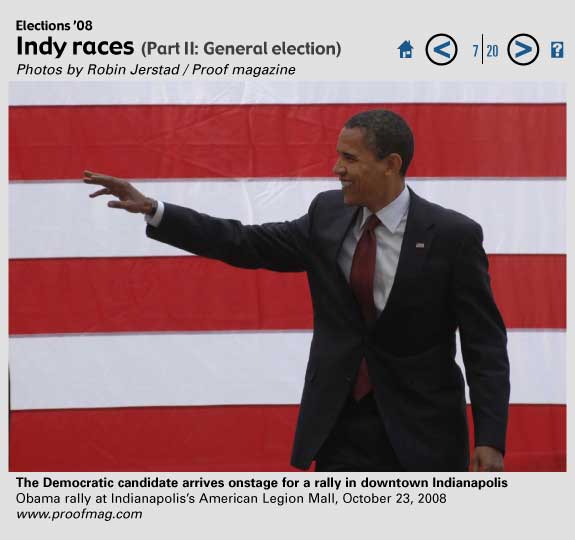
“I got the impression at this event that the crowd already knew he would win the state and the election,” says photographer Jerstad. “It was more like a coronation than a campaign rally. I talked to some [crowd members] after the event and they said it was a day that they would remember for the rest of their lives.”
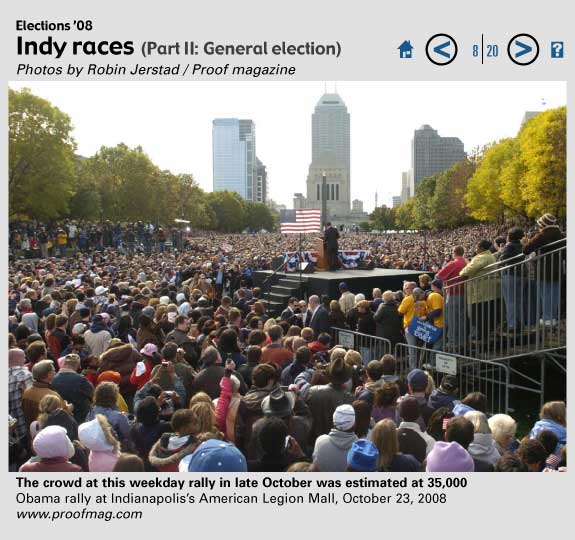
Professional pollster Michael Barone is among those who believe that Obama’s superiority in grass-roots organization, developed during the primary season, made a big difference in states like Indiana in the general election.
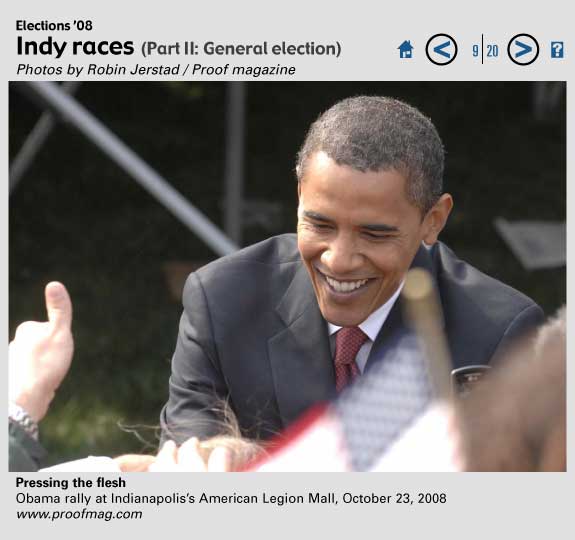
Jerstad comments: “I was always impressed by how healthy Senator Obama looked. Despite a gruelling schedule, he always looked fresh to me. . . . He seemed to engage each and every person he spoke to as if he’d known them for a long time.”
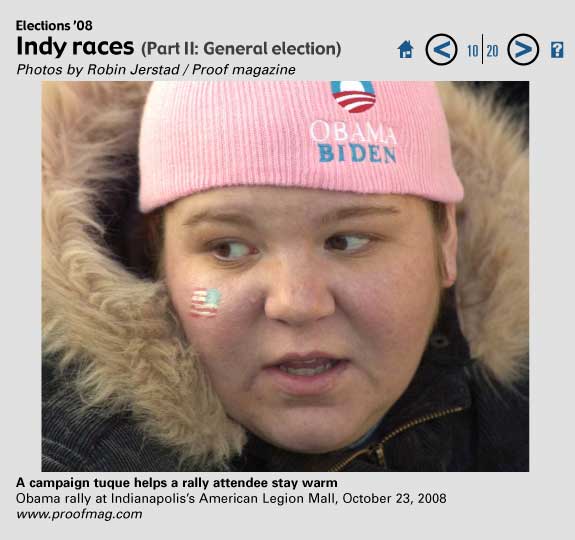
Two-thirds of the under-30 vote nationwide went to Obama, according to CNN’s report on Election Day exit polling.
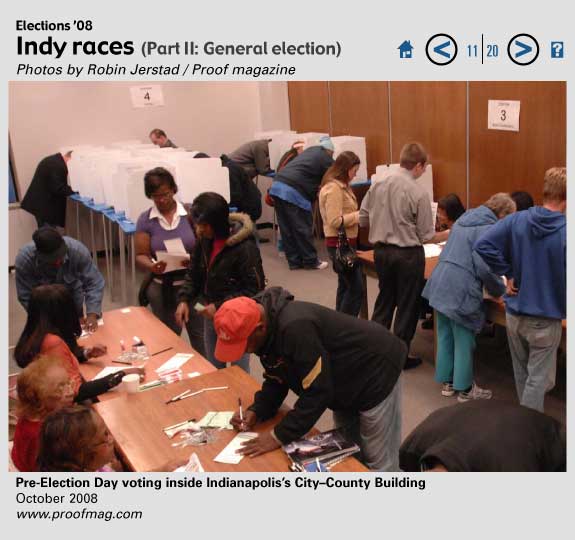
Indiana allows any registered voter to vote “absentee-in-person” beginning 29 days before Election Day. Early voting ended at noon the day before Election Day in most Indiana counties.
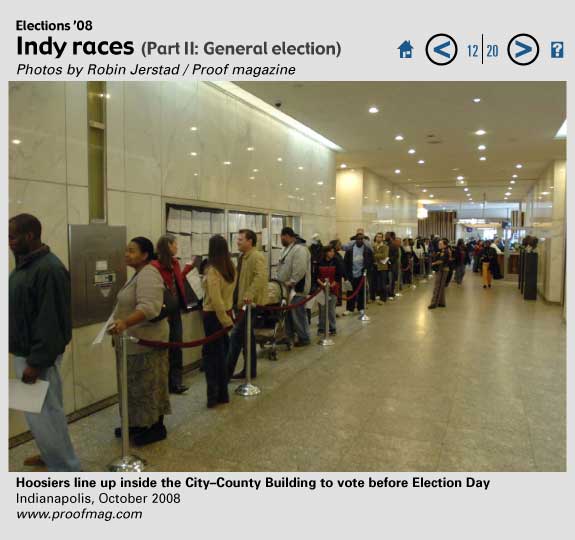
The numbers of early voters “seemed to grow exponentially each and every day,” says Jerstad. “It almost became the fad to vote that way.” The AP estimated that some 572,000 Hoosiers—12% of the state’s registered voters—took advantage of early voting this year.
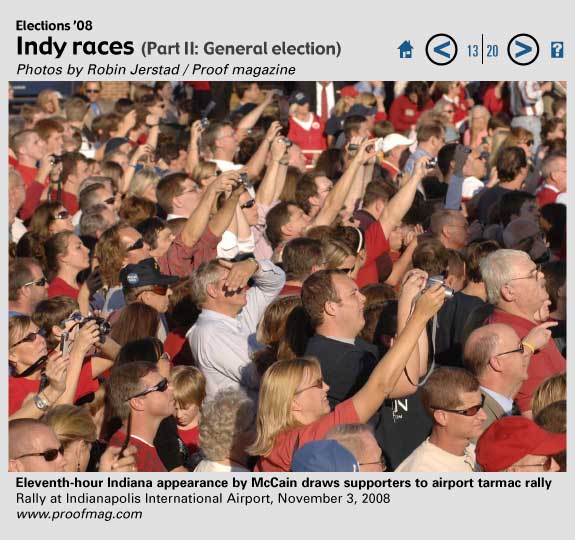
This was McCain’s third campaign visit to Indiana. His prior visit had been on July 1.
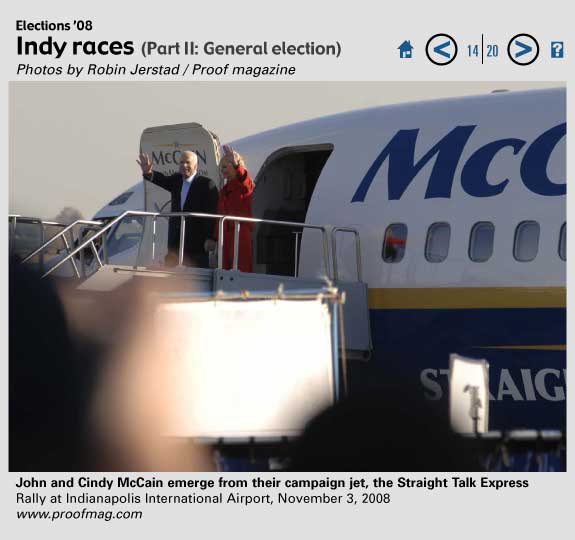
McCain’s plane flew almost directly over the crowd on its approach, prompting a burst of cheers, says Jerstad. “I felt like the crowd truly believed that they were going to see the man who was going to win the election the next day.”
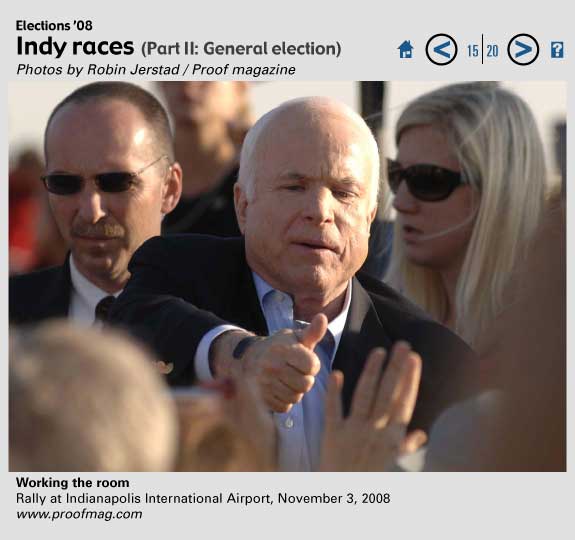
Jerstad continues: “It was also just a gorgeously sunny day which really made for a high saturation quality of the images.” McCain’s visit to Indianapolis was part of an election-eve tour that touched down in seven states.
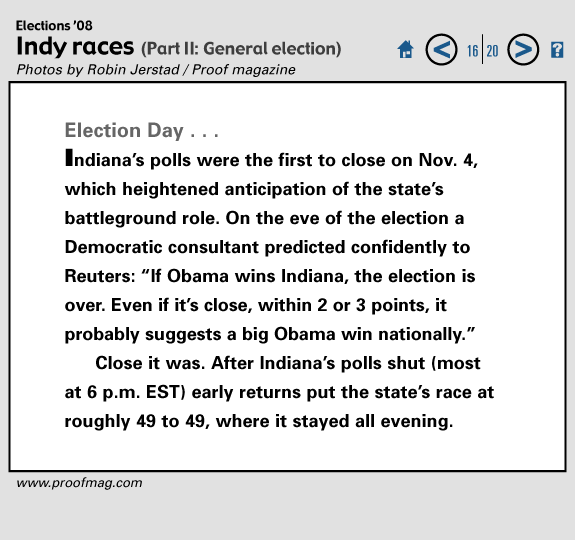
After voting in Chicago, Obama traveled to Indiana for his final 2008 campaign stop. McCain voted in Phoenix, then made two final campaign appearances in Nevada and Colorado.
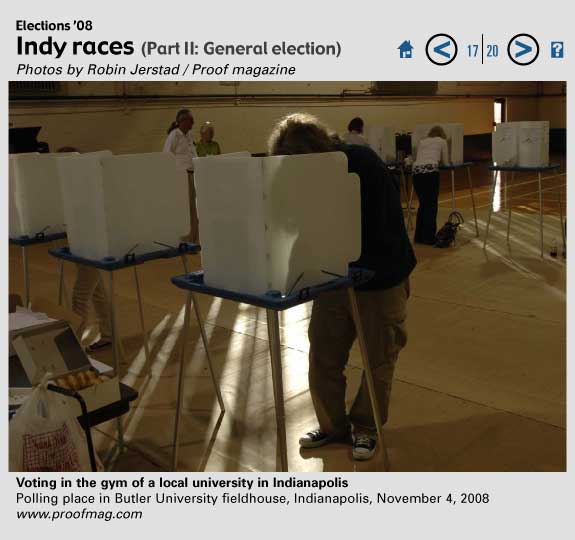
Indiana’s turnout in this year’s general election was up some 11% over 2004. “The day was just beautiful here. . . . Warm sunny weather really contributed to the high turnout. It made it a joy to shoot,” Jerstad recalls, adding: “I really like the way the light worked out on [this shot].”
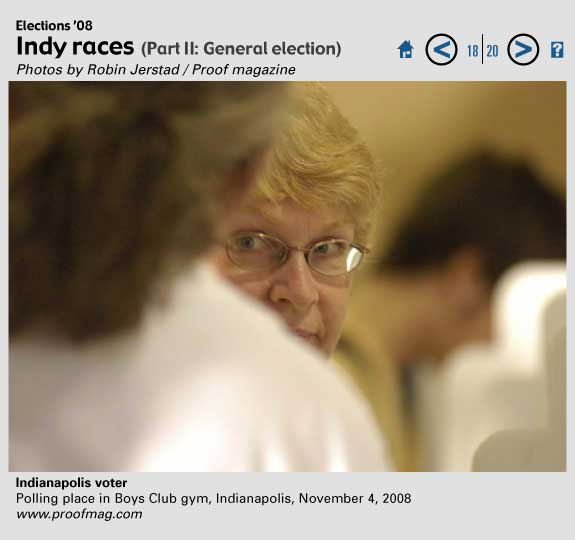
“This woman seemed unsure of what she needed to do, what the process was,” the photographer continues. “Shortly after the image was taken, a poll worker nicely answered all her questions and she went about her business.”
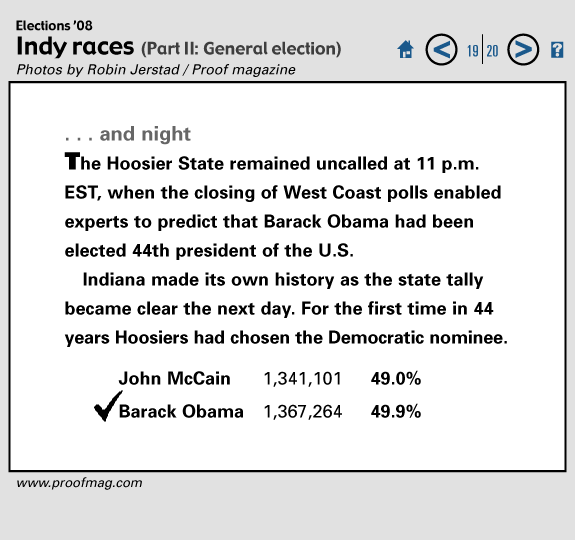
Indiana was one of four states still uncalled when Obama concluded his victory speech after midnight. Of the other three: Montana was called the next day for McCain, North Carolina two days later for Obama; at this writing (three weeks after Nov. 4) Missouri remained too close to call.
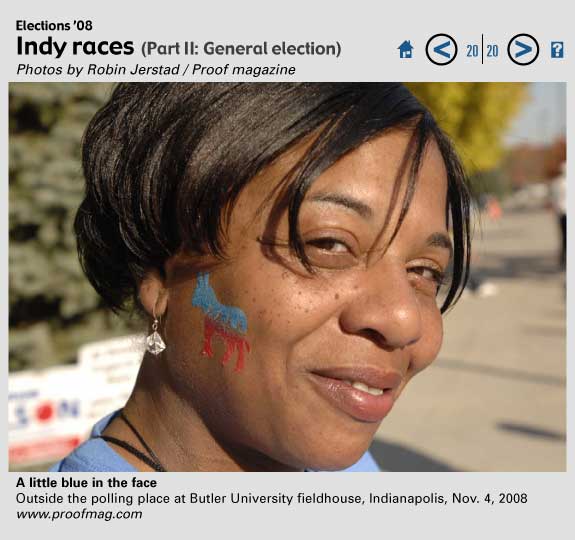
TIP: Hover your cursor over the index pages for convenient access to all of the bonus commentary.